This Notebook collects references to, and sometimes reprints of, technical texts and images of the cutting of typographical patrices in soft metal by hand. For a set of links to all locations in CircuitousRoot which discuss patrix engraving (including arguments and evidence for its historical importance), see ../../ Patrix Cutting in Soft Metal (By Hand and Machine).
Earlier references to patrix cutting were short on technical information, but sometimes do contain useful technical facts. For an attempt at a complete list of these, see the Survey of the Data in the Issue of Patrix Cutting in Soft Metal Notebook. The cutting of patrices in soft metal assumes that matrices will be electroformed from them. For the literature on this subject, see ../ Electroforming Matrices. For practical studies [at such time as I get to them] see the book ../../ Making Matrices .
For the literature on patrix cutting by (pantographic) machine, see ../ Machine Engraving.
There is considerable overlap between patrix cutting and punchcutting. For a set of links to locations in CircuitousRoot which discuss punchcutting, see ../../ Hand Punchcutting in Steel.
Note: See the box of legal notices at the bottom of this page for a discussion of the status of the in-copyright illustrations below and the argument for reprinting them here.

One Hundred Years (1896)
In 1896, the Philadelphia branch of American Type Founders, operating as if it were still MacKellar, Smiths & Jordan, published a sumptuous folio volume commemorating the century of their existence: One Hundred Years. The icon at left links to the presentation of that volume in the General Literature on Making Printing Matrices and Types Notebook.
In their discussion of type-making, they illustrate patrix cutting by hand:
Here's a close-up of the engraver:
They describe the process in this way:
"Most every one in reading has noticed a particularly sharp outline about script and italicized letters which makes it impression upon the eye in print. That is because most of these, like Roman and other body type, are cast from matrices made with punches which are cut on steel in the manner described. Few large-faced type, however, are made from such matrices.
Strange to say, it is by the electrotype process that some of the most satisfactory and uniform matrices are produced, and it has the additional advantage that whole fonts, including ornaments and everything, can be made at once, or small quantities of different letters be turned out quickly and with ease. Nevertheless quite as much care is required in the preparatory stages of this process of matrix-making as in punch-cutting, though in this no punch is used. Pieces of metal softer than that of which type is made (which would be too brittle) have the letters cut on them very sharp and clear, and these specially engraved type or ornaments, or whatever they may be, have the letter or figure on them reproduced in the battery, the action of which causes copper to be deposited around the face of the type in the holes of the brass plates, of which there is one for every figure, letter, or point, to be made. The portions of the plates not intended to be exposed to the action of the battery are covered with wax before they are put in. Matrices can be made this way in the battery now by an improved process in a few days.
"When the metal letter types are withdrawn from the plates their images appear imbedded in copper, and this, when filed and attached to a brass plate, becomes in turn a matrix ready to reproduce type after its fashion and proportions when it has been finished, though the finishing requires some expensive machinery, and also dexterity on the part of the fitter." (p. 47)
Note: It isn't clear what the workman in the background is doing. He seems to be operating a pantograph of a kind not otherwise attested.

Koch (1923; Poortenaar (1935))
I hesitate to cite this as an example, because I'm not at all certain that it isn't a chimera. Moreover, at present I'm working from a third-hand source, Gerald Cinamon's Rudolf Koch: Letterer, Type Designer, Teacher. (New Castle, DE and London: Oak Knoll Press and The British Library, 2000): 94) This is a fine book, but from it I am doing nothing more than citing its quotation of Jan Poortenaar's The Art of the Book and its Illustration (London: George G. Harrap & Co., Ltd): 25. Poortenaar, if read literally, suggests that Koch may have created his type Neuland by patrix-making. But Poortenaar, in turn, is a writer about books, not a typefounder.
The quotation from Poortenaar reads:
"The outline of his Neuland was made by filing off the corners of metal quadrats, the opening having been produced by punchcutting."
"Metal quadrats" means, literally, typemetal spacing material and implies patrix cutting. Yet this would have been patrix cutting of an unusual kind: using only the file (to produce a counterpunch, presumably in steel, for punching "the openings" (the counters)).
On the one hand, Neuland (1923) was the first type that Rudolf Koch made with his own hands. Starting with typemetal seems not unreasonable. Moreover, in Koch's 1931 article "Von Stempelschneiden" he dismisses the graver as "unnecessary" and writes (in translation) that "the tools of the punch-cutter are file and hammer" (in Gutenburg-Jahrbuch (1931), translated and printed as "On Punch Cutting" in The Colophon, No. 10 (1932). Quoted in Cinamon, p. 146)
On the other hand, in the same article Koch rails against the machine. He is referring specifically to the pantographic engraving machine, but it is hard to reconcile Koch's moral insistence upon hand craftsmanship with the modern industrial process of electroforming.
We know also that patrix cutting with gravers was being done at the Klingspor foundry at this time (see the illustration by Willi Harwerth, below) - but Koch accused these craftsmen of "superficiality" and was going his own way.
However, if Koch did indeed work in this way, then this becomes an interesting technical citation because I am at present unaware of any other reference to the use of counterpunching in patrix cutting.
There is another piece of evidence which is suggestive (though not conclusive). At left below is a photograph of Rudolf Koch at his workbench in his "Werkstatt" (the studio he founded in 1921). and at the right is his workbench at the Klingspor foundry (shown just after his death in 1934). Both photographs are reproduced from Cinamon. He dates the Werkstatt photo to "circa 1928." Klingspor released Neuland in 1923.
The workbenches are similar - in each the vise is the same, for example. But at the Werkstatt bench there is no punchcutter's bench pin. Instead, there is an engraver's bag.
This isn't conclusive evidence for at least three reasons. First, Koch was also doing wood engraving in the Werkstatt. Second, if this Werkstatt phogograph is indeed from 1928 then it postdates Koch's second hand-cut face, Jessen-Schrift (which I am presuming was cut in steel). Finally, Koch wrote so strongly against the use of the graver that it is difficult to square an engraver's bag with his work on Neuland. (Yet, as a counter-counter argument, there are gravers present on his Klingspor punchcutter's bench. What one writes and what one does can be two different things.)
In summary, I do not yet know if Poortenaar was writing precisely about Koch's techniques or loosely in suggestive terms to explain a then-unusual typeface. For the present, pending more information, this reference from Poortenaar should be taken as an unexplained possibility, not as an established fact.
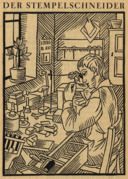

Harwerth [Klingspor] (1924)
1924 Klingspor Kalender [title on cover] / Ein Kalender auf das Jahr neunzehundertvierundzwangig mit Bildern der handwerklichen Vewrrichtungen, die in unserem Betriebe gepflegt werden. (Offenbach am Main, Germany: Gebr. Klingspor, 1923.) this is a booklet-format calender for 1924 published by the Klingspor Type Foundry. It is illustrated with twelve woodcuts by Willi Harwerth showing various manual typefoundry operations. The illustration for January, "Der Stempelschneider," shows a patrix engraver at work.
This illustration has, however, been identified at least once as representing a "punch cutter" (in Gerald Cinamon's exemplary biography Rudolf Koch: Letterer, Type Designer, Teacher. (New Castle, DE and London: Oak Knoll Press and The British Library, 2000): 145).
There are several indications that this Stempelschneider is cutting a patrix, not a steel punch. The telltale sign is the presence of the Lötwerkzeug (lead-work tool; soldering iron) - a tool for which the punchcutter in steel has no use. (For a positively identified photograph of this tool, see Bohadti (1954), below.) It is hard to see the workpiece itself, but the positions of the hands of this Stempelschneider correspond well to a left-handed patrix engraver holding a patrix blank with his right hand and a graver with his left.
It is probably also significant that the illustration for Feburary shows Der Galvanoplastiker electroforming a matrix (rather than a justifier justifying a strike).
Finally, the text section which appears in this calendar booklet before the calendar pages describes Der Stempelschneider and Der Galvanoplastiker thus:
"Der Stempelschneider schafft mit Stichel und Feile nach der gezeichneten Vorlage das plastische Modell des Buchstaben. Für die kleinen Schriftgrade schneider en einen Stahlstempel, der zur Erzielung der Gießform in Kupfer oder Eisen eingeprägt wird. Die Größeren Grade werden in Schriftmetall geschnitten, von ihnen wird die Matrize im galvanischen Bad des Galvanoplastikers hergestellt, der nebenbei auch Vervielfältigungen von allen Arten von Druckstöcken vornimmt."
I won't assault the German tongue by attempting to translate this, but it is pretty clear that it says that the "Stempelschneider," using gravers and files, make punches in steel ("Stahlstempel") for the samller type sizes and patrices in typemetal ("Schriftmetall") for the larger sizes. These typemetal patrices are then used by der Galvanoplastiker to electroform matrices.
This is fairly good evidence that the German term "stempelschneider" (literally, punch cutter) signifies not only a punch cutter in steel but also a patrix cutter in soft metal. This second meaning is not present in the English term "punchcutter."
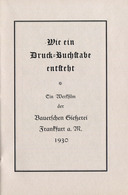
Bauer (1927, [1928], 1930)
Wie ein Druck-Buchstabe entsteht: Ein Werkfilm der Bauerschen Gießerei. (Frankfurt am Main: Bauersche Gießerei 1930) In 1927, 1928 (according to Worldcat), and 1930 the Bauer type foundry produced this small booklet showing type-making at their foundry. I have examined the 1927 edition and own the 1930 edition. Both contain the same illustration of hand patrix cutting over the caption "Handstempelschneider." The work is being done on an engraver's sand or shot bag. The book does not illustrate hand or machine punchcutting, although it does show an unjustified matrix strike which must have been produced from a punch. It shows the pantographic machine direct engraving of matrices (but not punches or patrices). I can't read German, so I'm not sure if the text mentions these things.
(According to Christopher Burke, in his book Paul Renner: The Art of Typography (NY: Princeton Architectural Press, 1998), the British distributor for Bauer, Soldans, issued a translation of this booklet under the title From Sketch to Type. Worldcat dates this translated edition to 1932. I have not yet been able to locate a copy.)

Mahr (1928)
Mahr, Karl. Der Druckbuchstabe: Sein Werdegang in der Schriftgießerei dargestellt in Holzschnitten und Versen . ([no location, but Mahr in Frankfurt a. M.]: Verein Deutscher Schriftgießereien E.D., 1928).
Three of these illustrations (the Hand Punch-Cutter, the Matrix Engraver, and the Handcaster) from Mahr were reproduced in the 1937 volume by the Bauer Type Foundry, Human Touch. (NY: The Spiral Press, 1937).
The image here, of "Der Stempelschneider" (but showing a patrix cutter at work) is reproduced from the 1937 Spiral Press publication).
[TO DO: I should work through the various tools shown here, as this illustration is particularly important in documenting the history of patrix engraving. For the present, though, in the Notebook on General Literature on Making Printing Matrices and Types see the entries for Mahr (1928), Human Touch and especially the sub-Notebook Mahr. The Hand Punch-Cutter, which begins to identify these tools. Please note, though, that I wrote those pages before fully understanding both the importance of patrix engraving and some of the finer details of the various tools of both the punchcutter and the patrix cutter.]
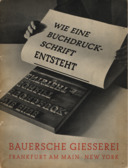
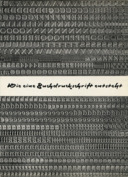
Bauer (1930s, 1950s)
In the 1930s (undated, but probably 1933) Konrad F. Bauer 1 wrote an updated version of his firm's booklet on type-making under a new title, Wie eine Buchdruckschrift entsteht. (Frankfurt am Main: Bauersche Giesserei, n.d. [1930s]). A revised edition appeared two decades later. The images at left are of the covers of the two editions. For a more complete discussion of this work, see the entry for these works in the Notebook of General Literature on Making Printing Matrices and Types.
Two sets of illustrations which appear in parallel in both volumes pertain to patrix cutting. The first of these is unproblematic. Below left is a photograph from the 1930s edition (p. 4) captioned "Schneiden des Stahlstempels mit der Hand" - cutting steel punches by hand. Its most interesting feature is the form of the punchcutter's bench pin, which has no cutouts on its front working surface. Below right is the photograph which took the place of this in the 1950s edition, captioned "Der Stempelschneider bei der Arbeit" - the punchcutter at work. It shows a stempelschneider (in this case meaning a patrix engraver) cutting a patrix. The most interesting thing about this photograph is, again, the form of the bench pin used, which does have a cutout (patrix engraver usually is depicted using either a bench pin without cutouts, an engraver's bag, or a flat steel plate on top of an engraver's bag).
The second pair of images presents a problem, however, because I believe that the earlier of the two is inaccurate due to an error by the photographer. First, here are the two pages from the 1930s and 1950s editions which show the stages of punchcutting (top band) and patrix cutting (bottom band):
The top pair of images, of punchcutting, are unproblematic. In each edition, they show:
For the bottom pair of photographs, of patrix cutting, first consider the one on the right (from the 1950s edition). It is, I believe, correct.
Now look at the corresponding version from the 1930s edition.
Remember: the printed word and matrices are right-reading, but type, punches, and patrices are wrong-reading. Yet the patrix shown in this sequence is right-reading, And the electroformed piece (here called the "Auge" or "eye") is opposite-reading to the matrix formed by backing it up with zinc. Clearly something is wrong.
I believe that the clue to the solution is to be found in the line which appears on the side of the patrix blank and the finished patrix in the 1950s version. A punchcutter would call this line a "signature." It marks a known side of the punch so that the punchcutter can tell which side is top and which is bottom. It is clear that patrix cutters adopted the same device, for the same reason. Here, the signature appears on the bottom side of the patrix, just as the nick appears on the bottom side of the type.
But in the 1930s version, while the nick is there on the type, no signature appears on the patrix. This is, I think, because the photographer placed the patrix blank, patrix, and initial electroformed "Auge"/eye top-side down. Because the slab-serif letter 'D' is symmetric across the horizontal axis, it isn't possible to deduce this just by looking at the letter. 2 But if you reverse the patrix and the electroformed "eye" all of these difficulties disappear (and undoubtedly a signature would appear).
It can be difficult to see just how the "eye" (Auge) was "backed up" by zinc from the illustrations above. Prof. Indra Kupferschmid has an excellent photograph, taken at Rainer Gerstenberg's type foundry, showing several such matrices which have failed (the "eye" has come off). This shows quite clearly their construction. See her blog posting "Making Matrices" of 2015-09-17 on the "Alphabettes" site at: http://www.alphabettes.org/making-matrices/
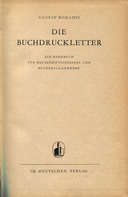
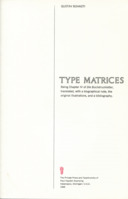
Bohadti (1954) / Duensing (1968)
Bohadti, Gustav. Die Buchdruckletter: Ein handbuch für das schriftgiesserei- und buchdruckgewerbe. West Berlin, West Germany: Ullstein A. G., 1954.
Duensing, Paul Hayden, trans. & ed. Type Matrices: Being Chapter IV of Die Buchdruckletter, translated, with a biographical note, the original illustrations, and a bibliography. (Kalamazoo, MI: The Private Press and Typefoundry of Paul Hayden Duensing, 1968.)
Bohadti's 1954 book is probably the most comprehensive technical account of matrix making and typefounding from the mid-20th century. It is in German, which is a difficulty for those who cannot read German (I cannot). Fortunately for us, the late Paul Hayden Duensing translated the chapter on matrix making. The first icon above is just an image of the title page of Bohadti's original text. The second icon links to a PDF of a scan of Duensing's translation (or click here). Please note: While Duensing's translation, done with Bohadti's permission, is in the public domain, Ginger Duensing asks that Paul Hayden Duensing always be identified as its author. Good scholarship demands no less. Also note that this is a "quick and dirty" scan of this work intended to make the information available to colleagues engaged in practical type-making. As a digital document, it shows clear signs of haste. I am also in the process of assembling an archive, physical and online, of the work of Paul Hayden Duensing. At a future point, I will be doing a better-prepared digital edition.
Bohadti treats of all three methods of matrix making as equal (punchcutting in steel, patrix cutting in soft metal with subsequent matrix electroforming, and direct matrix engraving) - though if anything the relatives weights of his treatment emphasize patrix cutting. This work is, to the best of my knowledge, the most extensive technical account of patrix cutting that we possess.
Although Duensing's translation uses some of the illustrations, it only contains a few of the line drawings. The original contains many more illustrations of various aspects of typefounding. Two black-and-white Plates and one page of illustrations are of particular interest to the student of patrix cutting (and punchcutting). But the two Plates, in particular, have not always been correctly interpreted.
The image shown above (which is the top photograph in the Plate on p. 161) is captioned "Der Stempelschneider," but does not show a punchcutter. Rather, it shows a patrix cutter. He is working against a bench pin (but as we will see below this pin does not have the cutouts used by the punchcutter) on a typemetal block, and his tools include the "Lötworkzeug" ("lead-work tool," soldering iron) - a tool unknown to the punchcutter in steel.
The Plate shown above, on p. 171, shows an array of tools of the patrix engraver. Many of these are identical with those of the punchcutter. But the array of tools contains the Lötwerkzeug ("lead working tool," a form of gas-heated soldering iron), which is used for work in typemetal, not steel.
Note on the shape of the Gravers: At first I thought that there was some significance to the overall relief angles of the gravers shown. They are much more acute than those we used in Stan Nelson's 2016 Wells Book Arts Summer Institute class in punchcutting in steel. Similar acutea angles are shown for cutting typemetal in Schmets' Vom Schriftgießen. (1987), q.v. But then I saw the earlier image of a punchutter in steel in the 1930s edition of Konrad Bauer's Wie eine Buchdruckschrift entsteht . The graver used there for punchcutting in steel seems identical in its overall relief angle to the gravers shown here for typemetal.
Note on the shape of the Bench Pin: Also, at first I thought there was some significance to the fact that the "Gravierbock" (punchcutter's bench pin, Carter's "peg," Moxon's "Tach"), which is shown with a patrix on it, does not have the cutouts on its working edge needed by the punchcutter. But in looking further: the punchcutter in steel shown in the 1930s Bauer Wie eine Buchdruckscrift Entsteht (p. 4) is shown using a bench pin without cuts, while in the 1950s edition of the same work a patrix engraver is shown using a bench pin with a cutout. It would seem that the shape of the front working edge of the bench pin is a matter of individual preference. The extreme case of this might be in the film The Last Punchcutter, which shows a punch being cut in steel on an engraver's sand or shot bag which in turn is resting upon a punchcutter's bench pin.
(These two Plates also appear on a photoset in the flickr account of interrobang918 (Michael Babcock, Interrobang Letterpress) devoted to Schmets' Vom Schriftgießen (1987) . Michael quite carefully points out that they are not from Schmets' book.)


Rimmer (1984, 2003)
In 1984, the great independent Canadian type-maker Jim Rimmer published two versions of his account of cutting patrices for his face Juliana Oldstyle. The first appeared in the American Typecasting Fellowship Newsletter , Vol. 9 (May 1984): 27-31 under the title "Original Font Cut in Lead, Matrics [sic] Are Electroformed." (Note that this issue was mis-identified as No. 11 on its masthead.) This account was not illustrated. Later in 1984 the text of this article ( plus drawings by Rimmer of his techniques, a specimen, and a showing) was reprinted under the title "Engraving Type Designs in Lead" in The Devil's Artisan, No. 15 (1984): 14-20. (This is the title as it appears with the article. In the Table of Contents it was given as "Engraving Type Designs in Metal.") The first icon at left links to the presentation of this issue of the ATF Newsletter. I do not yet have permission to reprint the version which includes Rimmer's illustrations.
Rimmer's article occupies a special place in the history of patrix engraving. On the one hand, he was working outside of the oral traditions of the type foundries. So while he knew generally how it had been done, as far as details went he was probably making things up as he went along (and doing so quite successfully, as always!) On the other hand, this article is the most detailed practical study published at any time in the 20th century on this subject. If you plan to attempt patrix engraving in your own shop, you owe it to yourself to acquire a copy of The Devil's Artisan 15 with Rimmer's illustrations.
A keepsake was distributed along with a later (2003) issue of The Devil's Artisan devoted entirely to Rimmer ( DA 52, see below) which was a self-portrait of Rimmer cutting a patrix under a stereo inspection microscope. It does not actually show the patrix, but it does confirm his use of a stereo microscope. 3
Rimmer later cut patrices by machine for Carl Dair's face Cartier. This project progressed through at least trial castings, but was never fully completed due to problems with using the pantograph. See Jim Rimmer, "The Cutting of Cartier in Metal" DA, A Journal of the Printing Arts [formerly The Devil's Artisan], No. 52 (Spring/Summer 2003): 15-20

Schmets. Vom Schriftgießen. (1987)
Schmets, Ronald. Vom Schriftgießen: Porträt der Firma D. Stempel, Frankfurt am Main. (Darmstadt: Technische Hochschule Darmstadt, 1987). ISBN: 3-88607-050-6.
This is a photographic study of all aspects of the making of type at the Stempel type foundry at a very late point in its existence. The matrix making methods shown are (first) patrix cutting and matrix electroforming and (second) direct matrix engraving. Punchcutting is not shown at all.
Three of the photographs in Schmets show patrices or patrix engraving.
The photograph above left is the fourth one in the book. The quite acute angle of the graver is evident. The photograph above right is the fifth one. Note the use of an engraver's sand or shot bag under the work. The identity of the patrix cutter is not revealed in the book. This image is captioned "manueller Zeugschnitt" (literally "manual tool cutting," or hand cutting).
The photograph above left (6th in the book), captioned "Tieferlegen des Zeugschnitts mittels Handhobel" shows the planing down of the shoulder of a patrix. Unfortunately, it doesn't show the entire machine being used, but from the form it must be some form of metalworking shaper (I would presume a hand-operated one, given the term "Handhobel" - hand planer). The next image in the book shows the same craftsman engraving by hand a working pattern for machine engraving - using the same engraving tools. Following that (8th image, shown above right) is a view of some of these tools.
Images from this book have been put on the flickr account of interrobang918 (Michael Babcock, Interrobang Letterpress). Note that the last two images in the interrobang photo-set are not from this book but, as Michael notes, instead are from Bohadti (see above).

Wilkes (1990)
Wilkes, Walter. Das Schriftgießen: Von Stempelschnitt, Matrizenfertigung und Letterguss: eine Dokumentation von Walter Wilkes . (Darmstadt, Germany: Technische Hochschule Darmstadt, 1990.) also (Stuttgart:, Germany Hauswedell, 1990). ISBN: 3-7762-0311-0 (same for both Darmstadt and Stuttgart editions). ISBN-13: 978377620311.
Wilkes' monumental work actually has relatively little on hand punch or patrix cutting (its strength is its remarkable survey of machine methods). But it does have a full-page photograph (p. 42, fig. 43) of a patrix cutter at work on a bench which contains both an engraver's sand or shot bag and a punch/patrix cutter's bench pin.
Wilkes identifies the source of this photograph as the Archiv D. Stempel at the Technische Hochschule Darmstadt. Stan Nelson has identified the patrix engraver shown in this photograph as August Rosenberger.
He also presents a series of images of the process, viewed from straight above (p. 43, fig. 44). They show a patrix blank with guidelines scribed on it, the blank with a letterform transferred to it, the letter's outline cut out, and, finally, the finished patrix. Here I've rearranged these views in a horizontal format. Wilkes credits them to Reinhard Stolzenbach of Darmstadt.
The film The Last Punchcutter (Bologna, Italy: Griffo the Great Gala of Letters [Associazione Francesco Griffo da Bologna], [filmed Dec. 2014], 2016) http://griffoanniversary.com Online at: https://vimeo.com/169673676 presents an interesting puzzle. It shows the cutting of a punch in steel, but the tools used seem at times more appropriate for patrix cutting in soft metal (e.g., the use of an engraver's sandbag). See the main entry for this film in the Notebook of literature on Punchcutting in Steel by Hand.
1. Konrad F. Bauer (1903-1970) was "no relation to Johann Christian Bauer" [founder of the Bauer Type Foundry). K. F. Bauer was the head of the Bauer Type Foundry's art department from 1928 to 1968. See: Eason, Ron, Sarah Rookledge, Phil Baines (ed), and Gordon Rookledge (ed). Rookledge's International Handbook of Type Designers: A Biographical Directory. (Carshalton Beeches, UK: Sarema Press (Publishers) Ltd., 1991): 23. N.B., this volume has now been replaced by Macmillan, Neil [no relation to the author of CircuitousRoot]. An A-Z of Type Designers. (New Haven, CT: Yale University Press, 2006.)
2. Theological fact: There is a special place in Hell reserved exclusively for those who document the technology of type-making using symmetrical letters.
3. The contemporary punchcutter in steel Richard Årlin also uses a stereo microscope. It may be seen in his video "Stämpel till typ" at https://www.youtube.com/watch?v=Kx3nTsnRMmE Årlin's microscope is a Greenough style instrument. The style of Rimmer's isn't clear to me from the illustration; it might be Greenough or it might be a Common Main Objective instrument (not that it really matters here).
The illustrations reproduced here, in reduced resolution, from Bauer (1927, 1930), Bauer (1930s, 1950s), Klingspor, Bohadti (1954), Schmets (1987), and Wilkes (1990) are in copyright worldwide. I will argue, however, that their reproduction here falls within "Fair Use" under US copyright law (1) as this present Notebook constitutes a review of (and in some cases a scholarly analysis of) the original books, (2) as their presentation here is in no way a substitute for the purchase of the original book (all of which are out of print - for as long as 89 years), and (3) as they are important resources for the scholarly understanding of the nearly forgotten field of making letterpress printing type by patrix engraving. Also, students of other type-making crafts such as punchcutting have available to them a wide range of illustrative material, but although patrix engraving is over 170 years old, these are the only images of it which presently exist. Please note, however, that these arguments may not apply to any further re-use of these images either in the US or in other countries. If current owners of these copyrights exist and would prefer these images to remain unseen by those who need them most, please contact me and I will take them down (alternatively, should you care to grant explicit permission, I would be happy to add credits and a note to that effect).
The image from Mahr is taken not from his 1928 German publication but from Human Touch (NY: Bauer Type Foundry / Spiral Press, 1937). This is in the public domain due to the failure of this book to comply with copyright formalities, as then required, upon publication.
All portions of this document not noted otherwise are Copyright © 2016 by David M. MacMillan and Rollande Krandall.
Circuitous Root is a Registered Trademark of David M. MacMillan and Rollande Krandall.
This work is licensed under the Creative Commons "Attribution - ShareAlike" license. See http://creativecommons.org/licenses/by-sa/3.0/ for its terms.
Presented originally by Circuitous Root®